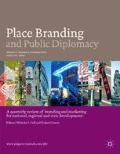Abstract
This article examines the history of public diplomacy and identifies seven lessons from that history. These are: (1) public diplomacy begins with listening; (2) public diplomacy must be connected to policy; (3) public diplomacy is not a performance for domestic consumption; (4) effective public diplomacy requires credibility, but this has implications for the bureaucratic structure around the activity; (5) sometimes the most credible voice in public diplomacy is not one's own; (6) public diplomacy is not ‘always about you’; and (7) public diplomacy is everyone's business. The article considers the relevance of these lessons for ‘the new public diplomacy’, which have emerged over the last decade. Cull concludes that this new public diplomacy era has opened up fresh possibilities, but has not erased the relevance of the history of public diplomacy. On the contrary, the lessons of the past seem even more relevant in an age in which communications play an unprecedented role.
Similar content being viewed by others
Notes
For an account of Gullion and the origins of the term see Cull (2008a).
This taxonomy is explored in Cull (2008b), in a special issue: Public Diplomacy in a Changing World, co-edited with Geoffrey Cowan.
The conclusion to Cull (2008c) also identifies seven lessons from the history of US public diplomacy many of which are US specific. The international scope of this publication has enabled more general observations and a wider set of lessons.
The classic exposition of this case is Dudziak (2000).
Analects of Confucius (Lun Yu) XVI, I, (434).
For a detailed history see Heil (2003).
This case is explored in Cull, The Cold War and the United States Information Agency.
For a case study of recent use of Scottish voices see Cull (2008d).
For a detailed study see Mayne (2003).
Lord Carter of Coles was asked by the Foreign Secretary and Chief Secretary to the Treasury to conduct ‘an independent review of public diplomacy’ and examine the effectiveness of current public diplomacy activities. His Public diplomacy review was completed in December 2005.
See Krotz (2002), also Vion (2002).
The key exploration of this idea is Melissen (2005).
On the credibility of ‘people like me’, as indicated by the Edelman trust barometer survey see http://www.edelman.com/news/ShowOne.asp?ID=102.
References
Cull, N.J. (2008a) Public diplomacy: The evolution of a phrase. In: N. Snow and P.M. Taylor (eds.) The Handbook of Public Diplomacy. London: Routledge, pp. 19–24.
Cull, N.J. (2008b) Public diplomacy: Taxonomies and histories. Annals of the American Academy of Political and Social Sciences 616: 31–54.
Cull, N.J. (2008c) The Cold War and the United States Information Agency: American Propaganda and Public Diplomacy, 1945–1989. New York: Cambridge University Press.
Cull, N.J. (2008d) The National Theatre of Scotland's Black Watch: Theatre as Cultural Diplomacy. London/Los Angeles: USC Center on Public Diplomacy/British Council, http://www.britishcouncil.org/files/documents/usa-arts-theater-black-watch-cultural-pub.pdf.
Dudziak, M. (2000) Cold War Civil Rights: Race and the Image of American Democracy. Princeton, NJ: Princeton University Press.
Heil Jr, A.L. (2003) Voice of America: A History. New York: Columbia University Press.
Krotz, U. (2002) The Ties that Bind: The Parapublic Underpinnings of Franco-German Relations as Cons-truction of International Value. Minda de Gunzburg Center for European Studies, Harvard, October 2002, http://www.ces.fas.harvard.edu/publications/docs/pdfs/Krotz4.pdf.
Mayne, R. (2003) In Victory, Magnanimity, In Peace, Goodwill: A History of Wilton Park. London: Frank Cass.
Melissen, J. (ed.) (2005) The New Public Diplomacy. London: Palgrave.
Vion, A. (2002) Europe from the bottom up: Town twinning in France during the Cold War. Contemporary European History II (4): 623–640.
Author information
Authors and Affiliations
Corresponding author
Rights and permissions
About this article
Cite this article
Cull, N. Public diplomacy: Seven lessons for its future from its past. Place Brand Public Dipl 6, 11–17 (2010). https://doi.org/10.1057/pb.2010.4
Received:
Revised:
Published:
Issue Date:
DOI: https://doi.org/10.1057/pb.2010.4



